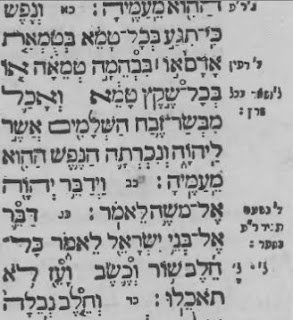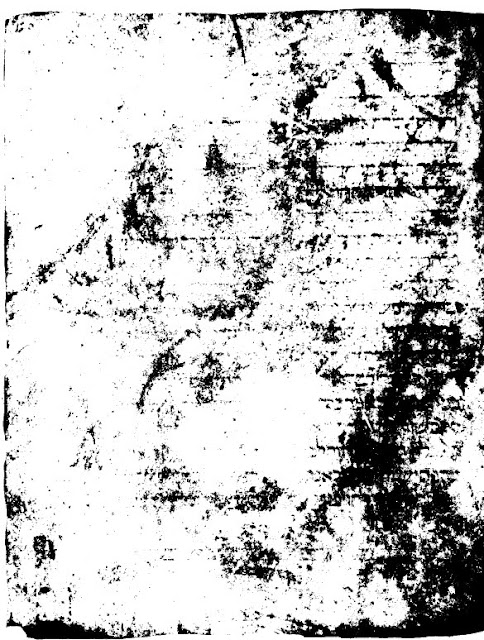But according to this Tanach, with masoretic notes on the side, there is no petucha. And the same in our Mikraos Gedolos.
As we might expect, the Teimanim follow the Rambam. The Rambam based his listing of petuchot and setumot on the Ben Asher, Aleppo Codex. And Rambam writes in his
Mishneh Torah, as recorded at mechon-mamre once again, in Hilchot Sefer Torah 8:8:
ח ספר ויקרא--ואם מן הצאן, סתומה; ואם מן העוף, פתוחה; ונפש כי תקריב, וכי תקרב, ואם מנחה, ואם מנחת, ואם תקריב, חמשתן סתומות; ואם זבח, ואם מן הצאן, ואם עז, וידבר, ואם כל עדת, אשר נשיא, ואם נפש, ואם כבש, ונפש כי תחטא, כולן פתוחות, והן תשע; ואם לא תשיג, וידבר ה', שתיהן סתומות; ואם נפש, וידבר דנפש, וידבר דצו, שלושתן פתוחות; וזאת תורת, סתומה; וידבר דזה קרבן, וידבר דדבר אל אהרן, וזאת תורת האשם, וזאת תורת זבח, וידבר דדבר אל בני ישראל, וידבר דקח את אהרן, כולן פתוחות, והן שש;
This is a run of six petuchot, and וידבר דדבר אל בני ישראל is the one under discussion.What about us? Don't we have this in our Rambam? Well, not precisely. We have the following:
We have the extra word "hamakriv". This would, then, not be 7:22, but rather 7:28:
The quotation of pesukim is once again from mechon-mamre, and they do not have a petucha.
This is as we should expect, because Rambam either writes one or the other. Either the word hamakriv is there, or it is not.
So what, then, should we expect of that Tanach with masoretic notes on the side? Indeed, it has a petucha in that place!
So which one is it? A? Or B?
Rambam, in that very perek, tells us that he relied upon the Aleppo Codex. And so, the ideal thing to do would be to go to the Aleppo Codex and see what petuchot it has. Alas, most of the Chumash portion of the Aleppo Codex was burned, and some pages are still in existence but in private hands, and so we cannot consult the Aleppo Codex on this matter.
However, where the Aleppo Codex is deficient, we turn to the Leningrad Codex, another Ben Asher codex. And there, we have:
Note the two petuchot. In the actual manuscript, the first one is marked by a blank line, because the preceding pasuk ended at the end of a line:
and the second one is marked as a gap until the end of the line:
And so, we have option C. Rather than A or B, we have A and B.
Perhaps we could apply logic and the skills of textual analysis to determine which is the most likely. After all, each petucha immediately follows venichreta hanefesh hahi mei'ameha, and leads into a vaydaber Hashem el Moshe leimor. So perhaps each deserves its own section; or perhaps they should be grouped together; or perhaps, depending on the subject matter therein, the first should be grouped with the preceding and the second by itself. The problem with this approach is that I am sure convincing arguments can be leveraged for different sevarot, and there is no way to know that any given one is the one which influenced those who marked off the petuchot and setumot.
Going back to Rambam, it is difficult to see how both A and B can be squared with his words. He only lists one, not two, petuchot. And he even states that the count of this group of petuchot is six, rather than stating that they number seven!
In the text of the Rambam itself, if mere scribal error were at play, then I would argue that it is far easier to accidentally omit the word hamakriv than to add it. But as we know from elsewhere, even in context of hilchot sefer Torah in terms of how many lines in Haazinu, people modified the Rambam to conform to local customs. And a scribe could have made this deliberate change, or else "helpfully" added a word of clarification to show which vaydaber was intended. So this approach cannot really be of much assistance.
On the other hand, since there is a list, and the list would contain the same text twice (if two petuchot were the original), it is easy to see how a sofer, while copying, could have skipped over one of them.
Let us check out other manuscripts. In the Lisbon Codex,
there appears to be a gap in the former instance, but if it is, it is a setuma. And it might just be a space made in order to evenly fill out the line. But in the second instance, it surely is a petucha!
In terms of Codex Hilleli, I cannot make heads or tails out of it. Unfortunately, the text on this page is extremely mangled and difficult to read. The sentence on the preceding page is bimkom asher tishacheit ha'olah tishachet hachatat, in 6:18. and the sentence on the subsequent page is vehayah hechazeh leAharon uvanav, in 7:31. In between, we have the following two columns, quite obscured:
Perhaps these letters can be reconstructed, on the basis of the partials and on the basis of the font size. And then we might be able to make out a petucha or two. I don't have the time to do this right now, nor do I know if it is really possible, but this is one way to continue this investigation. (Later on, Or Torah says that he found it as petucha in Hilleli.)
On the Rambam, we have the statement from Hagahot Maimoniyot (same link as above). The footnote (6) was placed on the wrong word. It should have gone on the phrase under discussion:
"6. The are {actually} two of them {such that merely וידבר דדבר אל בני ישראל, as the Teimanim have, is ambiguous). And I searched and investigated in all the good sefarim which I found, and I discovered that both of them are petuchot. And I then thought that there is a scribal error here {in the Rambam, which only lists one}. And even though the sum adds up on either side {namely, to six}, perhaps this was also written based on the error {as a scribe may have "fixed" the seemingly erroneous count}. And so I further found in a Tikkun sefer Torah which Rav Yosef Nakdan made, and he recorded from the Maimonidean za"l, daber of kol chelev is petucha; daber of hamakriv is petucha. And in the sum at the end of the chumash, he adds one petucha. Howbeit, he also adds an extra setuma, and I did not investigate after it, end quote."
Kesef Mishnah (=Rav Yosef Caro) adds some more detail, and cited a version of Rambam in which the count is seven:
"It is written in the sefarim of our Rabbi {=Rambam} .... Vaydaber of daber el Bnei yisrael {7:22}, vaydaber el bnei yisrael hamakriv {7:28}, vaydaber of kach et aharon, all of them are petuchot and they are seven." And the fifth is the vaydaber of kol chelev {which is 7:22}. And so is found in some sefarim of Rabbenu explicitly. And so is found in Hagahot Maimoniyot. And it is obvious that vaydaber of kol chelev is not a {new} parasha. Therefore, we need to pass the quill over the vaydaber of vaydaber el bnei yisrael {7:22} {and cross it out from the words of the Rambam}. And similarly to pass the quill over "and they are seven" and to write in its place "and they are six." And so I found in a corrected sefer of Rabbenu."
This reveals that the count of six, which is "correct on all sides", could have been a correction. After all, there was a version which listed both, and which gave an explicit count of seven. One of them must be a correction of the other. And we see how Kesef Mishnah is willing to emend the text of the Rambam to existing other texts, and much on the basis of sevara.
Or else (/and) it could have been corrected to conform to local practice. See what happened with the number of lines in Haazinu, and how Cassuto was misled into thinking the Aleppo Codex was not real, since it did not conform to the Rambam. In reality, people changed some manuscripts of Rambam to conform to local practice.
Indeed, given the convergence of these factors, I am leaning towards a Hagahos Maimoniyos conclusion. We know the Rambam relied on a Ben Asher Codex, we have a (different) Ben Asher Codex which has both marked as petucha, we have texts of the Rambam with both petuchos listed and with a count of seven. And while there are other versions (either our printed one or the Yemenite one) which chooses only one petucha and puts the count at six, we also know that people were emending the Rambam precisely in details such as this.
With all this behind us, what is left is to consider Minchas Shai and then Or Torah. Minchas Shai is relatively short:
"Vaydaber of daber el bnei yisrael leimor, kol cheilev shor, etc: In many sefarim there is here a peh of petucha. And so is written in Hagaha Maimoniyot, and in sefer Chagai. Also the Meiri instructed to do so in his sefer Torah. However, he himself {=Meiri} wrote that in the sefer of the Rama this is not a {new} parasha. And to this, Rav Caro za'l {=Kesef Mishna} agreed, and wrote that so did he find in an corrected {edited} Rambam. And so as well have I found in precise manuscripts from Sefarad. And Or Torah goes on at length about this."
I am running short on time, so I will have to save Or Torah, and the related discussion, to a follow-up post.













6 comments:
Do I understand correctly in Parshas Tzav that the Ibn Ezra had an argument with a Karite where he said that CHelev from a non Korban is ok I saw it in the Ramban just wanted to see if i Understood correctly as the Ramban Shlogs Up all of his his Arguments?
yes; i discuss it from the Ibn Ezra's perspective in this post.
I didn't analyze (or even translate) the Ramban's counterargument there. I can imagine several good rejoinders with which ibn ezra might have responded. This might be a good follow-up post...
thanks,
josh
in the meantime, an interesting read is the Karaite response to Ibn Ezra on the pasuk in Tzav, from Aharon ben Yosef, here:
http://jnul.huji.ac.il/dl/books/djvu/1124884/index.djvu?djvuopts&thumbnails=yes&zoom=page&page=149, starting on the bottom of the second column on the first page.
kol tuv,
josh
Thanks
By the way, another data point, the first edition printed Rambam (Rome 1480) has petuchot in both 7:22 and 7:28.
thanks. i see it.
bli neder, i'll include the image in the next post in the series:
http://jnul.huji.ac.il/dl/books/djvu/1771813-1/index.djvu?djvuopts&thumbnails=yes&zoom=page&page=36
kt,
josh
Post a Comment